|
Memphis and
The Civil War |
|
...in
Vintage Drawings and Photos |
|
|
|
Initially, most Tennesseans showed little enthusiasm for
breaking away from the nation. In 1860, they had
voted by a slim margin for the Unionist John Bell, a
native son and moderate who continued to search for a
way out of the crisis. In 1861, 54 percent of the
state's voters voted against sending delegates to a
secession convention, defeating the proposal for a State
Convention. If it had been held, it would have
been very heavily pro-Union. But with the attack
on Fort Sumter on April 12, 1861, and Lincoln's call for
75,000 volunteers to put the seceded states back into
line, public sentiment turned dramatically against the
Union. |
 |
|
|
| |
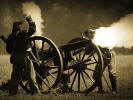 |
In
a June 8, 1861 referendum, East Tennessee held firm against
separation, while West Tennessee returned an equally heavy
majority in favor. The deciding vote came in Middle
Tennessee, which went from 51 percent against in February to 88
percent in favor in June. Having ratified by popular vote
its connection with the Confederacy, Tennessee became the last
state to formally declare its withdrawal from the Union. |
|
|
|
|
|
|
|
Click on the small photos to see an
enlargement. |
|
|
|
|
|
|
|
 |
In the
1860s, Memphis was a lively and thriving, riverboat town with
more than its share of bordellos and saloons. There was a
Main Street and a Beale Avenue.
Along
Main Street, one could find all types of shops and businesses,
as well as numerous hotels, restaurants, and theatres.
Riverboats loaded with cotton lined the riverbank and nearly
400,000 bales a year were being sold in Memphis. The city
was on its way to becoming the largest cotton market of the
world. |
|
Memphis
Landing |
|
|
|
|
 |
 |
 |
 |
|
The Memphis Bluff 1864
|
Memphis Landing 1864 |
Main Street 1860s |
Beale 1860s |
|
|
|
|
In
1862, Memphis serves briefly as the State Capitol when Nashville
fell to the Union in March of that year. All the
state records were stored in the Masonic Temple at Madison and
2nd.
=>
After
the war, the Tennessee Governor convened the state legislature
from this building. |
 |
 |
|
|
Masonic
Temple |
Marker |
|
| |
| |
|
The Battle of
Memphis ... |
| |
|
This
naval battle was fought on the Mississippi River below the city on
June 6, 1862. The result was a crushing defeat for the Rebels
and marked the virtual eradication of a Confederate naval presence
on the river. In spite of the lopsided outcome, the Union Army
failed to grasp its strategic significance. It's primary
historical importance is that it was the last time civilians with no
prior military experience were permitted to command ships in combat.
The battle remains as a demonstration of the ill effects of poor
command structure. |
| |
 |
 |
 |
 |
|
Battle of Memphis |
Battle of Memphis |
USS Essex |
Battle of Memphis |
|
|
|
|
Union
officer Charles H. Davis moved down the Mississippi with a squadron
of ironclad gunboats. Accompanying him were six rams commanded
by Colonel Charles Ellet. The Confederate fleet, commanded by
James E. Montgomery, a riverboat captain with no military
experience, was going to move south to Vicksburg, but was
notified that there wasn't enough coal in the city to fuel his ships
for the voyage. While Montgomery technically commanded the
fleet, each ship was run by it's own civilian captain, who was empowered to
act independently once they left port. Compounding that
was the fast that the gun crews were provided by the army and served
under their own officers. But Montgomery's group decided to stand
and fight. |
| |

C. H.
Davis |
As the
Union fleet approached Memphis, Davis ordered his
gunboats to form a line of battle across the river, with the
rams in the rear. They opened fire on Montgomery's
lightly armed rams. They closed in and the battle
engaged at close quarters deteriorating into a wild melee.
They succeeded in sinking all but one of Montgomery's ships.
With the fleet eliminated, Davis approached the city and
demanded its surrender. Union casualties were limited to
one, while Confederate casualties are not known but most
likely they were between 180 and 200. The destruction of
the Confederate fleet eliminated any Confederate naval
presence on the Mississippi. |

Chas Ellet
|
|
|
|
 |
 |
 |
 |
|
Battle of Memphis |
Battle of Memphis |
Battle of Memphis |
Battle of Memphis |
|
|
|
 |
<=
Thousands
of Memphians watched the battle from the bluffs above the
Mississippi in an
area that would later be named "Confederate Park" . The
battle for Memphis lasted all of 90 minutes.
|
|
Thousands
watch from this Bluff
|
|
|
| |
|
 |
<=
After the battle, Union soldiers marched to the Post Office
and lowered the Confederate flag on the roof, replacing it
with the U. S. flag. Confederate sympathizers closed a
trap door which locked the soldiers on the roof. The Union Commander
threatened to shell the city if the city didn't surrender.
The soldiers were allowed to descend and within hours Memphis
was occupied and for the remainder of the Civil War, it would be an occupied
city.
The
occupation probably saved it from destruction, because the last few cities the Yankees had captured they burned to
the ground. |
|
Union Flag
flies over Post Office |
|
|
|
|
|
|
|
Occupied
Memphis ... |
|
|
|
|
 |
Ulysses S. Grant was ordered to Memphis to become district
commander of the Union
Forces. At the
beginning of the Memphis occupation, he made his headquarters
at the Hunt-Phelan home on
Beale Avenue, where he set up a tent on the lawn. The home's
library was used as his office but he slept in the tent as a bond with his men.
However, he soon moved to plush quarters at the nearby Hotel Gayoso,
where he also had the comfort of being joined by his wife
Julia and their children. |
 |
| Ulysses
Grant |
|
Julia
Grant-children |
|
| |
 |
 |
 |
 |
 |
 |
|
Photos of Ulysses S. Grant taken
in Memphis |
Hotel Gayoso |
Hunt-Phelan Home |
Hunt-Phelan Library |
|
| |
|
Grant arrived in Memphis June 23, and found the city in
“bad order, with secessionists governing much in their
own way.” He wrote, “In a few days I expect to have
everything in good order.” This included posting picket guards around
Memphis, ordering clergymen to omit prayers for the
Confederacy, and a provost marshal, backed up by three
regiments, is directed to keep order in the city. Grant
also orders his Union occupiers to behave themselves.
Wandering about, pilfering, or straggling are forbidden,
and the soldiers are told to stay in their camps.
Three
articles appearing in the Daily Appeal describe
incidents in the city shortly after the Battle of
Memphis. One of them refers to General
Grant
=> |
 |
| |
Daily Appeal
1862 |
|
| |
|
|
| |
 |
During occupation, Memphis becomes a center for troop disbursements and a
major shipping
center for supplies.
The
Hunt Phelan house serves as a hospital and lodge for wounded
Union soldiers. After the war a Freedman’s Bureau school
was established at the home. |
|
Soldiers
Hunt-Phelan 1863 |
|
|
|
|
 |
Davies Manor Plantation: Located just north of the stage
route between Memphis and Nashville, This was a popular stop for
soldiers from both sides. The plantation managed to operate
throughout the war despite many family members joining the
Confederate army. |
|
Davies Manor
Plantation |
|
|
| |
|
|
FORT PICKERING:
Confederate authorities had originally established Fort Pickering in 1861,
building on the site of a frontier-era fort.
Union commanders took over and imposed martial law and posted garrison forces.
At first it was generally a lenient occupation, in the hope of winning over secessionist citizens, who
comprised the great majority in Memphis. But finding that
these secessionists remained hostile and defiant, the authorities
adopted an increasingly harsh policy. This included the
seizure and destruction of private property, the imprisonment or
banishment of those who refused to take an oath of allegiance to the
Union, and the forcible emancipation of slaves.
|
|
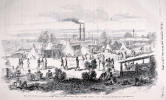 |
|
Fort Pickering |
|
|
| |
|
Ulysses
Grant appointed
General William T. Sherman as Commander of the Third Division
of the Army of Tennessee. Sherman ordered Fort Pickering expanded after
the Union takeover in 1862 and the site became one of the great
supply and staging areas in the West. Hundreds of slaves,
escaping from surrounding states, found work here. Camps provided
housing, churches and schools for the men. Later, some of the
ex-slaves manned the fort’s guns as U.S. soldiers. This was a
rough point for white Memphians. During his period in Memphis,
Sherman had very little to do, so he spent the time planning his "March to the Sea". |
 |
|
|
William T.
Sherman |
|
| |
 |
 |
 |
 |
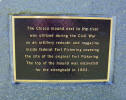 |
|
Sherman and
Officers |
Sherman's Tower |
Colored Regiment 1864 |
Sherman's Memphis Map |
Marker |
|
| |
| |
|
Generals Hurlbut and
Washburn:
Major General S. A. Hurlbut took command of Memphis after
Grant and Sherman. Like them he keep a tight clamp on
the city. Yet he continued their policy of allowing open
trade on the Mississippi and a local government as long as the
voters signed a loyalty oath. He tells Grant he has it
"under control, but is short of troops to stop the smuggling"
and asks to stay in charge. His successor is Major
General C. C. Washburn. He clamps down harder and closes
the open trade policy and suspends the city government.
Washburn remained in control until the war ended. |
 |
 |
| |
Gen
Hurlbut |
Gen
Washburn |
|
| |
|
*
Fort Pickering has its
own comprehensive coverage on another page of this website >
Click here |
| |
|
Resistance,
Smuggling,
and
Spying... |
| |
|
For most Tennesseans, Union occupation was a devastating
experience. Many left the city and became refugees
for the duration of the war. Those who stayed faced the
agonizing decision of whether, and/or how to resist the enemy.
The great majority did resist to some degree. The
boldest went beyond defiant to engage in active resistance,
smuggling and spying. Memphians found themselves
directly under the enemy's thumb and subject to constant
scrutiny. But there were also many advantages.
Army authorities provided police and fire protection, health
services, and courts of law. They doled out free
provisions to the needy and permitted the operation of
schools, churches, and markets. The Military Government
tried to get all Memphians to sign an "Oath to the United
States"
= > |
 |
|
| |
|
In
1863, the Memphis Chamber of Commerce sent Abraham Lincoln this
interesting letter asking that occupied Memphis should be
treated like a "loyal city". |
 |
| |
|
|
| |
|
Military occupation lasted more than three years and affected
Memphians attitudes more than the war itself. Although they
lived a relatively normal life during this period, Memphians hated
occupation rule and the city became a focus for illicit trade in raw
cotton, which was in great demand by northern cotton mills.
This trade in illicit cotton also corrupted the Union Army officers.
Union Army officials refer to Memphis as "Gomorrah of the West".
Yet they legalize and regulate prostitution during their
occupation - not that Memphis needed any help along these lines.
=> |
 |
|

|
<=
DAILY
APPEAL-
This is an artist rendering of what was the Memphis Daily
Appeal office in 1862. The retreat of the newspaper began June
6, 1862 when the printing equipment was loaded on a railroad
flat car hours before Federal gunboats smashed the Confederate
fleet and captured Memphis. Over the next three years, the
newspaper published in Grenada, Jackson and Meridian in
Mississippi, Atlanta, Georgia and Montgomery, Alabama until
April 6, 1865, when Federal troops destroyed the type at
temporary offices in Columbus, Georgia. Fortunately, the
press had already been smuggled out of town and
hauled from it's hiding place in Macon, GA to
Chattanooga, |
|
where it was loaded aboard a steamer bound for Cairo, Ill. The
newspaper resumed Memphis publication at No. 13 Madison Avenue
on Nov. 5, 1865.
|
| |
|
1862 - Hauling
sugar and cotton
from their hiding places for
shipment north. The City Ice House (left) was damaged by a
shell during the battle between Union and Confederate
gunboats in the harbor that preceded the city's capture
=> |
 |
|
| |
|
 |
 |
 |
 |
 |
 |
|
Burning Cotton |
Ginny
Moon-Spy |
Lotte
Moon-Spy |
Ginny Moon |
Belle Edmondson-Spy |
Isabella
Edmondson |
|
|
|
 |
 |
Many Women actually served as
soldiers in the army by disguising themselves as men.
One famous example is Cuban born Loreta Velazquez who became a
soldier and spy known as Harry T. Buford. She switched
back and forth from espionage and fighting in major battles to
traveling between New Orleans, Memphis, Richmond, collecting
information. |
|
Harry T. Buford -
Loreta Velazquez |
"Harry" in
Memphis Bar |
|
|
| |
| |
|
IRVING
BLOCK PRISON:
During the Civil War, this row of office buildings on Second Street,
opposite the northeast corner of Court Square had been a Confederate
hospital. After the fall of Memphis in 1862, the Union Army turned
it into a Civil War Prison to house Confederate sympathizers.
As a prison, conditions became so deplorable that even the prison
commandant was dismissed in 1864, but he was re-instated at the
request of General Grant. The prison had become known as "the
filthiest place ever occupied by human beings". It was so notorious
that it was eventually closed by order of President Lincoln himself
in 1865. |
| |
 |
 |
 |
 |
 |
|
Irving Block Prison |
The building 1907 |
Marker |
Two ladies to prison |
Restitution to Heirs |
|
| |
|
*
Irving Block Prison had
its own comprehensive coverage on another page of this website >
Click here |
| |
| |
|
HOSPITALS:
Being an occupied city earned Memphis its status as a major medical center
in the Mid-South. Wounded prisoners came by boat and wagon to
be treated at hospitals that began to specialize as the war
progressed. Prior to the war the city had one hospital.
By the end of the war, there were 15.
The Union used the hotels and warehouses of Memphis as a “hospital
town” with over 5,000 wounded Union troops being brought for
recovery. The Civil War was one of the "bloodiest" in history
- with over 620,000 casualties. The overwhelming operation
performed in hospitals was amputations.
|
 |
|
"Bloody" war |
|
| |
|
The new Overton Hotel at Main and Poplar was used as a hospital.
This
Hotel had not yet opened when the Civil War began. During the war
both sides used the building as a hospital and as quarters. After
the war ended, it officially opened as a hotel in 1866.
The Woolen
Building in Howard's Row is among the oldest buildings in Memphis
and was an early cotton trading center. In the 1850s it also housed
the large slave market of Isaac Bolton. It also served
as a hospital during the Civil War. |
| |
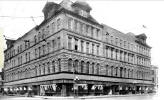 |
 |
 |
 |
 |
 |
|
Overton
"Hospital" |
1861 Article |
1863 Article |
1865 envelope
- Overton Hosp. |
1865 Letter from Overton Hospital |
|
| |
|
 |
 |
 |
|
 |
|
Woolen Bldg today |
Woolen Plaque |
Vintage Woolen photo |
|
Woolen Bldg today |
|
| |
|
A section
of the Gayoso Hotel was also used as an army Hospital, designed for
the reception of wounded patients only.
Female nurses
"prepared food, stocked shelves, and made the wounded as comfortable
as possible." The Gayoso team was led by Mother Mary Ann
Bickerdyke, perhaps the most famous nurse of the Civil War.
She became well known for her ability to bypass bureaucracy.
And she was the only woman ever allowed in Sherman's camps. |
| |
|
|
| |
|
The army hospitals in Memphis
were the Gayoso, the Adams, the Washington, the Webster, the
Jackson, the Union, the Jefferson, the Marine Hospital, and a small
Officer’s Hospital on Front Street. Two hospitals were set
aside for contagious diseases—the Smallpox Hospital, which was
located in the enlarge state-owned Memphis Hospital, and the Measles
Hospital, located in the First Baptist church. Later in July
1863, the First Baptist was reorganized as the Gangrene Hospital.
Successful experiments in the use of the bromine treatment of
gangrene were carried out there, which greatly reduced the mortality
of that dreaded wound complication. |
| |
|
|
|
|
|
*
Letters
from a Union Soldier to his wife: Thomas
Hannah, Jr., Illinois 95th Infantry, Company G, was stationed at
Adams General Hospital, Number 3, in Memphis from 26 January 1863 to
30 July 1864, serving as Ward Master. During this period he
wrote over 100 letters to his wife Elizabeth Marshall Hannah in
Belvidere, Illinois. He discusses life in Memphis and
speaks about the nurses with whom he worked.
Michael
Bryan Fiske, great, great grandson of Thomas Hannah, Jr. has
transcribed these letters and shared some of them with us. They are
all courtesy of the Family of Robert Huntoon Hannah, grandson of
Thomas Hannah, Jr. We think you'll agree that these letters
are unique. To visit a separate in-depth page on Thomas Hannah Jr..
with more letters ...
Click here. |
|
|
|
|
|
|
|
Union Casualties from
the siege of Vicksburg were evacuated mainly by hospital boat up the
river to Memphis. Later the same hospital boats were used to
transport patients from Memphis to St. Louis and on to Cairo.
Two of the more famous hospital ships were the City of Memphis
and the Red Rover, |
| |
 |
 |
 |
 |
| City of
Memphis |
Red Rover |
Red Rover
Ward |
Reinforcements for Grant's army |
|
| |
| |
|
The 2nd Battle of
Memphis...
Major
General Nathan Bedford Forrest became obsessed with freeing
prisoners from Irving Block Prison, and it was upper most in his
mind when he made a daring raid on the Union-held city in 1864. His
raid had three objectives: to capture three Union generals posted in
the city; to release Southern prisoners from Irving Block Prison;
and to cause the recall of Union forces from Northern Mississippi.
He struck early in the morning but didn't find the generals at Hotel
Gayoso,
although one, Major General Washburn made his escape to Fort
Pickering in his night shirt. Union troops were also able to prevent
the attack on Irving Block Prison. Although the raid had failed in
two of Forrest's objectives, he was successful in influencing Union
forces to return to Memphis from northern Mississippi, which did
provide the city more protection. |
|
|
 |
 |
 |
 |
|
Forrest` |
Hotel Gayoso |
Irving Block Prison |
Washburn Escapes |
|
| |
| |
|
Battle of Fort
Pillow AKA
known as Massacre of Fort Pillow
Fort Pillow was located 40 miles north of Memphis and this famous
battle was fought April 12, 1864. The battle ended with a
massacre of surrendered Federal troops by soldiers under the command
of Confederate Major General Nathan Bedford Forrest. |
| |
|
The fort had been a Confederate fort, but the rebels had
evacuated in order to avoid being cut off from the rest of the
Confederate army. Union forces took over and used the
fort to protect the river approach to Memphis. On this
date Forrest and his troops attached the fort with
considerable power, followed by frequent demands for
surrender. Union Major Booth refused to surrender.
After another attach, Major Booth was killed and the
Confederates swarmed over the fort. Up to that time few
Union men had been killed, but immediately upon re-claiming
the fort, the confederates seemed intent on indiscriminate
butchery of the whites and blacks, including the wounded.
They were bayoneted, shot, or sabred - men, women, and
children. The dead and wounded were piled in heaps and burned.
Out of the garrison of 600, only 200 remained alive. 300
of those massacred were negroes.
Union survivors claimed that the Confederates indiscriminately
killed Union troops, even as they tried to surrender.
Forrest and his officers stoutly denied that a massacre had
occurred and offered their own explanations of why so few
Union soldiers survived. A commission made up of North
and South was appointed to investigate. Both sides
concluded that there had been a massacre. Most
historians accept this verdict. What makes the issue so
controversial is that so many of the Union dead were African
Americans. |
 |
|
Harpers Weekly 1864 |
|
|
|
Leslie's Weekly 1864 |
|
| |
| |
| |
| |
|
Burying the dead ... |
|
|
 |
The Union held Memphis for the remainder of the war, taking
advantage of its transportation links and founding several hospitals
in the city to care for up to 5,000 wounded troops from across the
region. Many of these large concentration of injured troops
died while in Memphis, creating the need for a cemetery. A
site, 32 acres in northeast Memphis was selected, and in 1867, the
first burials were made. While originally called Mississippi River
National Cemetery, the name was shortened to "National Cemetery" in
1869. |
|
Memphis National Cemetery |
|
|
|
|
|
Over
1,000 Confederate soldiers and veterans are buried in
Confederate Soldiers Rest, in Elmwood Cemetery. Many other
Confederates are buried elsewhere in the cemetery. The first
burial was in 1861 and the final internment was in 1940. Union
soldiers were also buried here in the 1860s but almost all were
removed in 1868 and re-interred in Memphis National Cemetery.
Two Union generals remain at Elmwood.
There are 20
Confederate generals buried here. |
 |
| |
Elmwood Cemetery Confederate
section |
|
|
|
|
The Sultana
Riverboat Explosion of 1865 occurred when the ship's boilers
exploded and the ship sank near Memphis. It was the greatest maritime disaster
in U. S. History. 1,800 were killed, most of them Union
soldiers returning home after the end of the Civil War. Many of the victims
were originally buried at Elmwood
Cemetery. When National Cemetery opened in 1868, these
soldiers were re-interred there. Unfortunately their
wooden caskets were marked with chalk and that identification
was lost due to a rain in route to the cemetery. Thus
Memphis National Cemetery has the second largest population of
Unknown Soldiers in America. |

Sultana before explosion |

Sultana Marker |
|
|
|
|
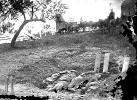 |
|
Confederate Burials |
|
|
 |
|
UCV |
|
Confederate soldiers couldn't be
buried in National Cemeteries, and they, nor their widows, were
eligible for benefits from the U.S. Government.
The
United Confederate Veterans was founded in 1889 to help as
a "benevolent, historical, social and literary Association".
Their primary functions were to provide for widows and orphans
of Confederate soldiers, preserve relics and mementos, care for
disabled soldiers, preserve records of service and to organize
reunions and gatherings where funds could be raised to support
their work. |
|
|
|
|
|
|
Reconstruction
... |
|
|
|
President Johnson wanted to restore the Union in as little time as
possible. While Congress was in recess, the president began
implementing his plans, which became known as Presidential
Reconstruction.
His plan offered general amnesty to all who would take an oath of
future loyalty.
Johnson
returned confiscated property to white southerners, issued hundreds
of pardons to former Confederate officers and government officials,
and undermined the Freedmen’s Bureau by ordering it to return all
confiscated lands to white landowners. Johnson also appointed
governors to supervise the drafting of new state constitutions and
agreed to readmit each state provided it ratified the Thirteenth
Amendment, which abolished slavery. Hoping that Reconstruction would
be complete by the time Congress reconvened a few months later, he
declared Reconstruction over at the end of
1865. |
| |
 |
 |
 |
 |
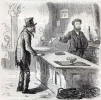 |
|
Andrew Johnson |
Reconstruction |
Idealic version of
Emancipation |
Inciting Riot? |
No Confederate Money... |
|
|
|
|
To coordinate efforts to protect the rights of former slaves and
provide them with education and medical care, Congress creates the
Freedman's Bureau. One of the bureau's most important functions was
to oversee labor contracts between ex-slaves and employers. |
|
|
|
|
|
|
|
The sudden emancipation of thousands of slaves, without property,
education and means of economic support, could have created a
demoralized class and led to total chaos and famine. The actual evidence
suggests a smoother transition than one might have expected. But it
was a lot for the Southerner to comprehend right after losing
a war for "The Cause..." and the transition certainly was far
from perfect ... |
|
|
 |
 |
 |
 |
 |
 |
| Amnesty Oath |
Carpetbaggers |
Emmancipation Proc. |
Education |
15th Amendment |
First Vote |
|
|
|
|
There was a strange "twist" at the end of the war in Memphis.
The city had escaped the destruction of so many other Southern
cities and it had a booming economy. When Lincoln signed the
Emancipation Proclamation which freed all slaves within
"Confederate-held territory" and allowed African Americans to serve
in the Federal army, Memphis was occupied by Union forces and no
longer a Confederate city. Ironically at war's end, slavery
continued unabated, not only in Memphis but in all of Tennessee, as
well. Congress quickly passed the thirteenth amendment and
Tennessee adopted the measure in December of 1865 - thus Slavery
ended in Tennessee. |
|
|
|
The
conflict between the races didn't end. Confederate
soldiers came home to a transformed society that gave as much
legal protection to a black laborer as it did to a white
planter. Many of the returning vets found this
intolerable and immediately set about to change things; if not
to the way they were before the war, then to something
similar. There were white-led race riots in Memphis, New
Orleans, and a host of other Southern towns between 1874 and
1876, where whites finally restored their control over the
cities. Thus, while the Civil War changed the legal status of
race in America, it didn't change people's hearts. |
 |
| |
KKK in
Memphis |
|
|
|
|
The Race Riots
of 1866... |
| |
|
During the War, Memphis became a haven for
freed slaves seeking protection from their former owners. The
black population increased from 3,000 in 1860 to 20,000 in 1865.
Racial tensions were heightened when black Union Army soldiers were
used to patrol the city. A riot was sparked on May 1, 1866,
when the horse-drawn hacks of a black man and a white man collided.
As a group of black veterans tried to intervene to stop the arrest
of the black man, a crowd of whites gathered at the scene. Fighting
broke out, and then escalated into three days of racially motivated
violence, primarily pitting the police against black residents. When it was over, 46
blacks and two whites had been killed, five black women raped, and
hundreds of black homes, schools, and churches had been vandalized
or destroyed by arson. |
| |
 |
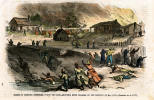 |
 |
|
 |
|
Harpers 1866 |
The Riots |
Burning Black Schools |
|
Riot Marker |
| |
|
|
|
|
|
|
The official report:
Through
early 1866, there were numerous instances of threats and fighting
between black soldiers and white Memphis policemen, who were mostly
(90%) Irish immigrants. Officials of the Freedmen's Bureau reported
that police arrested black soldiers for the minor offenses and
treated them with brutality. Although black soldiers were
commended for restraint, rumors spread among the white community
that blacks were planning some type of organized revenge. Trouble
was anticipated when most black Union troops were mustered out of
the army on April 30, 1866. The former black soldiers remained in
the city while awaiting discharge pay.
On the afternoon of May 1, the chronic hatred
between the city police and the now discharged black soldiers
erupted into armed conflict. Details of the specific incident that
initiated the conflict vary. The most widely held account is that
policemen were attempting to take into custody several ex-soldiers
for disorderly conduct and were resisted by a crowd of their
comrades. Some historians attribute the inciting incident to the
collision between two carriages of a black man and a white man.
After a group of black veterans tried to intervene to stop the
arrest of the black man, a crowd of whites gathered at the scene,
and fighting broke out. In each incident there was
confrontation between white police officers and black Union Army
soldiers. There also appeared to have been multiple confrontations
followed by waves of reinforcements on both sides, extending over
several hours. This initial conflict resulted in injuries to several
people and one policeman's death, possibly self-inflicted due to the
mishandling of his own gun.
The initial skirmish ended after dusk and the
veterans returned to Fort Pickering, on the south boundary of
downtown Memphis. Having learned of the trouble, attending officers
disarmed the men and confined them to the base. The ex-soldiers did
not contribute significantly to the events that followed.
The subsequent phase of the riots was fueled
by rumors that there was an armed rebellion of Memphis' black
residents.[5]
These false claims were spread by local officials and rabble
rousers. Matters were made worse by the suspicious absence of
Memphis Mayor John Park and the indecisive commitment of the
commander of federal troops in Memphis, General George Stoneman.
When white mobs gathered at the scene of the initial skirmish and
found no one to confront, they proceeded into nearby freedmen's
settlements and attacked the residents as well as missionaries who
worked there as teachers. The conflict continued from the
night of May 1 to the afternoon of May 3, when General Stoneman
declared martial law and order was restored.
No criminal proceedings were held for the
instigators or perpetrators of atrocities committed during the
Memphis Riots. The United States Attorney General, James Speed,
ruled that judicial actions associated with the riots fell under
state jurisdiction. However, state and local officials
refused to take action, and no grand jury was ever invoked. Although
criticized for his inaction, General Stoneman was investigated by a
congressional committee and was exonerated. The Memphis Riots did not mar his political
career as he was later elected governor of California (1883–87). |
|
|
|
Tennessee was the first of the seceding
states readmitted to the Union on July 24, 1866. Because
Tennessee had ratified the Fourteenth Amendment, it was also the
only one of the secessionist states that didn't have a military
governor during the
Reconstruction
period. |
|
|
|
|
|
Post Reconstruction
... |
|
|
|
After the formal end of Reconstruction, the struggle over power in
Southern society continued. For generations white Tennesseans had
been raised to believe that slavery was justified. Some could
not accept that former slaves were now equal under the law.
With violence and intimidation against freedmen and their allies,
White Democrats regained political power in Tennessee and other
states across the South in the late 1870s and 1880s. Over the next
decade, the state legislature passed increasingly restrictive laws
involving African Americans. In 1889 the General Assembly passed
four laws described as electoral reform, with the effect
of essentially disfranchising most African Americans, as well as
many poor Whites. Legislation included implementation of a poll tax,
timing of registration, and recording requirements. Tens of
thousands of taxpaying citizens were without representation well into the 20th century. |
|
|
|
The Jim Crow laws and "separate but equal" restrictive laws will
continue as a way of life for decades in the South, and to some
degree in other parts of the country. Racial segregation
will "officially" end with the Civil Rights Act of 1964.
|
 |
 |
| |
Colored Only Fountains |
Colored Waiting Rooms |
|
|
|
 |
 |
Confederate President Jefferson Davis was imprisoned for 2 years
and then the treason charges were dropped. He had no
money, property or income. Finally he is offered a job as
President of the Carolina Insurance Company in Memphis. He
and his family move to the city and live here from 1869- 1873.
His daughter is married in the house on Court. A young son
dies in one of the Yellow Fever epidemics and is buried at
Elmwood Cemetery. The Insurance Company goes bankrupt and
the family relocates to Biloxi, Mississippi where he dies in
1889. |
| Jefferson
Davis |
Memphis Home |
|
|
|
|
|
Confederate Park was dedicated in 1908 and planned as a Memorial
to the Civil War. It was part of the great designer George Kessler's
"Grand Design" for Memphis. During the War, the Mississippi
River below this park was the sight of an intense battle between
the Union and Confederate forces. Many lives were lost and
they are remembered at Confederate Park. Today, the park
provides a great perspective where the battle occurred and there
are markers to read first-hand accounts of the battle.
|
 |
 |
| |
Davis Statue |
Confederate
Park |
|
|
|
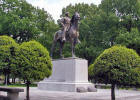 |
Forrest Park was established in the early 1900s and was another
of George Kessler's "Grand Designs for Memphis" parks. The
sculpture of Forrest is by Charles H. Niehaus, whose work can
also be seen at the Library of Congress. His sculpture is
considered one of the finest equestrian public park statures in
the U.S. It took him 3 years to model and nearly nine months for
the casting. It's 21' 6" high. The cost of $32,359.53 was raised
by private organizations. The bodies of Forrest and his wife
were re-interred from the Forrest family plot at Elmwood Cemetery to
Forrest Park in 1904. |
|
Forrest Park - Statue |
|
|
|
*
Forrest Park and the
story of the statue are thoroughly covered on another page of this
website >
Click here |
|
|
 |
When
Riverside Drive was constructed in the mid-1930s, Jefferson
Davis Park was built on what had been an old dumping ground for
construction debris and dredge materials from the Mississippi
River. It was enlarged to its present size in 1937, using more
material dredged from the river. The Park was named after
Jefferson Davis, the President of the Confederacy, who lived in
Memphis from 1869 to 1873 and who was president of an insurance
company here. |
|
Jefferson Davis
Park |
|
|
|
|
|
United
Confederate Veterans Reunions ... 1901, 1909, 1924
Memphis is
the only city to host three of the United Confederate Veterans
Reunions - which brought millions of dollars into the city. In
1901, the Reunion was considered so important to the city that an
astonishing $80,000 was raised to construct an 18,000 seat
Confederate Hall on the site of Confederate Park - the building to
be demolished at the end of the 3 day reunion. One of the
largest single donations of $1,000 came from the first black
millionaire Robert Reed Church. That first reunion in 1901 drew 125,000
visitors to the city. That's a lot of money. |
|
|
 |
 |
 |
 |
 |
|
1901 Front St |
1909 Bijou Theatre |
1909 Grand Parade |
1909 Grand Parade |
1924 Parade |
|
|
|
|
*
The UCV Reunions have
their own comprehensive coverage on another page of this website
>
Click here |
|
|
|
|
|
|
|
2013 Updates ... |
|
|
|
 |
 |
 |
|
Confederate Park |
Forrest Park |
Jefferson Davis Park
|
|
|
|
|
In
February 2013, without public notice, the Memphis City Council dropped all three names
of these parks and removed the
names from the signs at the parks because it said the names "evoked
a racist past and were unwelcoming in a city where most of the
population is black". As yet they have not come
up with "acceptable" alternate names for the three parks, but Confederate Park
may become "Memphis Park" or "Promenade Park".
Forrest Park may be named "Health Sciences Park" or "Civil War
Memorial Park" and Jefferson Davis Park may become "Mississippi
River Park" or "Harbor Park". There is
also a movement to rename one of the parks after civil rights activist
Ida B. Wells, and Mayor Wharton wanted to name one of them after
Maxine Smith, who fought for decades to have the graves and the
statue removed from Forrest Park. The outcome of the park
statues has not been decided. If past history is any
indication, the statues will be removed, placed in storage... and
quietly forgotten.
Update 2017:
In December the Memphis City Government quietly changed some laws
giving the city permission to sell Forrest Park (Health Sciences
Park) to a non profit company for $1000. The non-profit had
been created for this purpose and as soon as the bill of sale was
signed, large cranes went into action and removed the Forrest statue
and moved it to an unknown location. They also sold
Confederate Park (Memphis Park) and removed the statue of Davis.
Historic-Memphis website note:
FACT: There was an American Civil War. It was all about
slavery. Changing some names of Memphis Parks won't change
that. No matter what new name is applied to these parks,
there will always be a footnote about the original names that stood
for over a hundred years.
Renaming these
parks will not erase the South's greatest shame.
What the city council has done with this 2013 ruling creates an even
greater divide in Memphis racial relations.
As offensive as some find Confederate symbols, those symbols
represent Memphis history. That history should not be denied. It
is part of the South's good, bad and ugly, as well as the nation as
a whole.
To change names that are historically relevant is an attempt to
change the course of history. For a city government to attempt
to bury the past by pretending it didn’t exist is a major exploitation of power. Will the burning of history books be
next on their agenda? |
|
|
|
<><><><><> |
|
|
|
It's rare to find a large southern city that was virtually untouched
by the destruction of the Civil War. Memphis is one of those
rare cities. It should be the major treasure-trove of great
early southern architecture in America. Yet, virtually no
buildings from before the Civil War remain in the city.
Memphis continues to have this tendency to erase it's history or
not to come to terms with its historic identity. |
|
|
|
|
Masonic Temple
. Madison and 2nd
The building, dating from 1850, was demolished in the 1950s. |
| |
|
|
|
Hotel Gayoso . Main Street
This building burned in 1899. A grander Gayoso replaced it
in 1902, but never quite achieved its former glory. That
building still exists and has now been restored for use as
apartments, restaurants, and offices. |
| |
|
|
|
Hunt-Phelan Home . Beale Street
The building from 1828 still exists. Almost all the land has been
divided and the home itself is now on the "endangered list". |
| |
|
|
|
Davies Manor Plantation . Bartlett
The home from 1807 still exists. It's built as a
'log and chink' house made of squared white oak logs. The
name comes from Logan Davies who acquired the building in 1851.
He and his brother eventually added 2000 acres and put the land
to use as a plantation. |
| |
|
|
|
Fort Pickering
. on the Bluffs
The fort was demolished in 1866. Not one trace of it exists on the bluffs above the Mississippi. |
| |
|
|
|
Irving
Blum Prison . 2nd - at Court Square.
The buildings were demolished
in 1937 |
| |
|
|
|
Woolen Building . Union Avenue
This building still exists in the section known as "Howard's
Row" on Union Avenue.. |
| |
|
|
|
Overland Hotel - Main and Poplar
The Overland was sold to the city in 1874 and then used as a
court house until 1919. It was demolished in 1920 so Ellis
Auditorium could be built on the site. |
| |
|
|
|
Bijou Theatre -
Main and
Linden, Approximately where the Chisca Hotel is located.
The Bijou Theatre was as large as the Orpheum. It
burned in 1911 and was not rebuilt. |
| |
|
|
|
Jefferson Davis Home - 129 Court
This building was demolished
in the 1930s |
| |
|
|
|
|
| |
|
Civil War Memorabilia ... |
|
|
|
Confederate Coins, Bonds, and Currency...
It's worth more now than when it was in circulation
(It
was almost worthless when it was in circulation).
Be careful because the market is overrun with counterfeit
Confederate money. |
 |
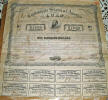 |
 |
| |
Very Rare Coinsq |
Confederate Bonds |
Bonds |
| |
|
|
|
|
|
 |
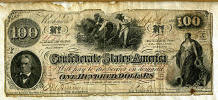 |
 |
|
20 CSA Dollars |
100 CSA Dollars |
500 CSA Dollars |
|
|
|
 |
 |
 |
 |
 |
 |
|
Canon |
Bugle |
Drum |
Uniform |
1861 |
TN War Vets |
|
|
|
|
|
|
|
|
|
|
|
 |
 |
 |
 |
|
 |
|
1864
Freedman's Documents |
1863
Telegraph |
1862 Order |
1863
Letter: Lady to Husband |
1864 Ordnance
|
|
|
|
|
|
|
|
|
|
|
|
|
|
|
|
|
|
|
|
|
|
|
|
|
|
|
Credits |
|
|
|
The
Historic-Memphis website does not intentionally post copyrighted
photos and material without permission or credit.
On
occasion a "non-credited" photo might possibly be posted because we
were unable to find a name to give credit. Because of the nature of
our non-commercial, non-profit, educational website, we strongly
believe that these photos would be considered "Fair Use. We have
certainly made no monetary gain, although those using this website
for historic or Genealogy research have certainly profited. If by
chance,
we have posted your copyrighted photo, please contact us, and we'll
remove it immediately, or we'll add your credit if that's your
choice. In the past, we have found that many photographers
volunteer to have their works included on these pages and we'll
also do that if you contact us with a photo that fits a particular
page. |
|
|
|
The "Historic-Memphis" website would like to acknowledge and thank the
following for their contributions which helped make this website
possible:
Memphis
Public Library, Memphis University Library, Memphis Law Library,
Memphis Commercial Appeal, Memphis Press Scimitar, Shelby County
Register of Deeds, Memphis City Schools, Memphis Business Men's
Club, Memphis Chamber of Commerce, Memphis City Park Commission,
Memphis Film Commision, Carnival Memphis, Memphis Historical
Railroad Page, Memphis Heritage Inc, Beale Street Historic District,
Cobblestone Historic District, Memphis Historic Districts, Vance
Lauderdale Family Archives, Tennessee State Archives, Library of
Congress, Kemmons Wilson Family, Richard S. Brashier, Lee Askew,
George Whitworth, Woody Savage and many individuals whose assistance is
acknowledged on the pages of their contributions. Special
thanks to Memphis Realtor, Joe Spake, for giving us carte blanche
access to his outstanding collection of contemporary Memphis photos.
We do not have high definition copies of the photos on these
pages. If anyone wishes to secure high definition photos,
you'll have to contact the photographer or the collector.
(To avoid any possibility of contributing to SPAM, we do not
maintain a file of email addresses for anyone who contacts us). |
|
|
|
|
|
|
|
|
|
|
|
|
|
<><><><><> |
|
|
|
|
|
|
|